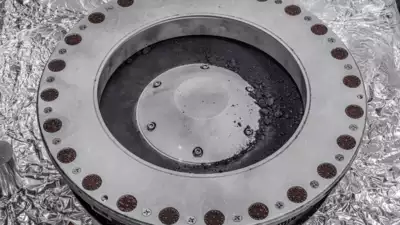NASA’s OSIRIS-REx Mission Reveals Abundant Water and Carbon in Bennu Asteroid Sample
Implications for the Seeding of Life on Earth from Space
In a groundbreaking discovery, NASA’s OSIRIS-REx assignment has unveiled a treasure trove of water and carbon in a sample amassed from the historic asteroid Bennu. This revelation holds significant implications for the concept that life on Earth might also have been seeded from outer space.
The OSIRIS-REx mission was no small endeavour. It involved a seven-year round-trip to Bennu, a distant asteroid with an intriguing history. After a successful rendezvous with the asteroid, the spacecraft collected a sample and then returned to Earth, culminating in the delivery of this invaluable payload in the Utah desert.
Carbon-Rich Asteroid Sample: An Extraordinary Find
NASA Administrator Bill Nelson made an astonishing announcement that this sample represents the largest carbon-rich asteroid material ever brought back to Earth. The sample comprises almost five per cent carbon, manifesting in both organic and mineral forms. Additionally, water is intricately locked within the crystal structure of clay minerals, a revelation that offers insight into the potential origins of Earth’s water.
Seeding Life on Earth from Space
One of the most profound implications of this discovery is its connection to the theory that life on Earth might have originated from outer space. The presence of water and carbon in celestial bodies like Bennu suggests that similar asteroids could have impacted Earth billions of years ago, bringing with them the crucial elements necessary for life. Scientists believe that the oceans, lakes, and rivers on Earth may owe their existence to water-carrying asteroids that collided with our planet during its early history, thus making it habitable.
The Crucial Role of Carbon
Carbon, a fundamental element for life on Earth, is at the heart of this discovery. It is the building block of all life, forming essential bonds with other elements, and enabling the creation of proteins, enzymes, and the genetic codes of DNA and RNA. The presence of carbon in Bennu’s sample provides tantalizing evidence for the theory that life’s fundamental ingredients are not exclusive to our planet.
State-of-the-Art Analytical Techniques
To unlock the secrets held within the Bennu sample, scientists employed an array of advanced analytical techniques. Scanning electron microscopy and X-ray computed tomography played pivotal roles in the preliminary analysis, enabling researchers to delve into the sample’s composition and structure.
Collaborative Endeavors and Worldwide Impact
The significance of this discovery is not confined to NASA or the United States alone. The sample collected from Bennu is being shared with laboratories worldwide, fostering international collaboration in the quest for knowledge about our universe. This cooperative approach reflects the global interest in advancing our understanding of celestial bodies and their potential influence on our planet.
A Record-Breaking Collection
While OSIRIS-REx is not the first spacecraft to return samples from an asteroid, it has set new records with the quantity of material it collected. The mission brought back an estimated 250 grams (about half a pound) of asteroid material, a substantial increase compared to previous missions such as Japan’s Hayabusa and Hayabusa2, which collected significantly smaller amounts.
Bennu: A Time Capsule from Space
Bennu, named after an ancient Egyptian deity, is a unique celestial object. It is often described as a “primordial artefact preserved in the vacuum of space.” Its composition and proximity to Earth’s orbit make it an alluring target for scientific investigation. Understanding Bennu’s properties can provide essential insights into the formation and evolution of our solar system.
Protecting Earth from Potential Hazards
Beyond the realm of scientific exploration, knowledge of Bennu’s composition has practical significance. While there is no immediate risk of a collision with Earth until at least the mid-2100s, the probability of such an event increases to approximately 1 in 1,750 between then and the year 2300, according to NASA. This information underscores the importance of understanding and monitoring asteroids like Bennu, as it could be crucial for devising strategies to mitigate potential hazards in the future.
Preserving the Legacy of Space Exploration
In a practice that harks back to the Apollo era with Moon rocks, NASA intends to preserve at least 70 per cent of the Bennu sample at its facility in Houston. This approach ensures that the samples will be available for future research, enabling new questions, new techniques, and new instrumentation to be applied for generations to come.
Sharing the Wonder of Space Exploration
The impact of this mission extends beyond the confines of scientific research. Select pieces of the Bennu sample will be sent for public display at renowned institutions like the Smithsonian Institution, Space Center Houston, and the University of Arizona. By making these samples accessible to the public, NASA aims to share the wonder and significance of space exploration with the broader community.
Conclusion
NASA’s OSIRIS-REx mission has not only deepened our understanding of celestial bodies like Bennu but also revealed tantalizing clues about the origins of life on Earth and potential future hazards from space. This historic endeavour is a testament to human curiosity, determination, and international collaboration in the pursuit of scientific knowledge. As we analyze the Bennu sample, we move one step closer to unravelling the mysteries of the cosmos and our place within it.

